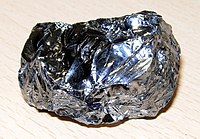
Photo from wikipedia
Abstract This study presents the results of the synthesis and characterization of chemically bonded phosphate ceramics (CBPC) material based on silica residues from furnaces used in power-generation plant enriched with… Click to show full abstract
Abstract This study presents the results of the synthesis and characterization of chemically bonded phosphate ceramics (CBPC) material based on silica residues from furnaces used in power-generation plant enriched with iron (III) oxide and silicon carbide. The sparsely soluble oxide, as required for the successful chemical bonding, was magnesium oxide and the phosphate derivative was ammonium dihydrogen phosphate. Various amounts of water were added. Morphology analysis of the SEM microphotographs revealed the presence of magnesium phosphates and magnesium silicates, confirmed by the MIR spectra. TG/DSC analysis provided an information on the thermal stability of the prepared phosphate ceramics, whereas mechanical tests gave an information on its mechanical strength. The results firmly suggest that silica residues contaminated with iron (III) oxide and silicon carbide (which normally interfere with setting of traditional cements) could find potential applications in CBPC ceramics which can be used inter alia in construction industry.
Journal Title: Journal of Molecular Structure
Year Published: 2019
Link to full text (if available)
Share on Social Media: Sign Up to like & get
recommendations!